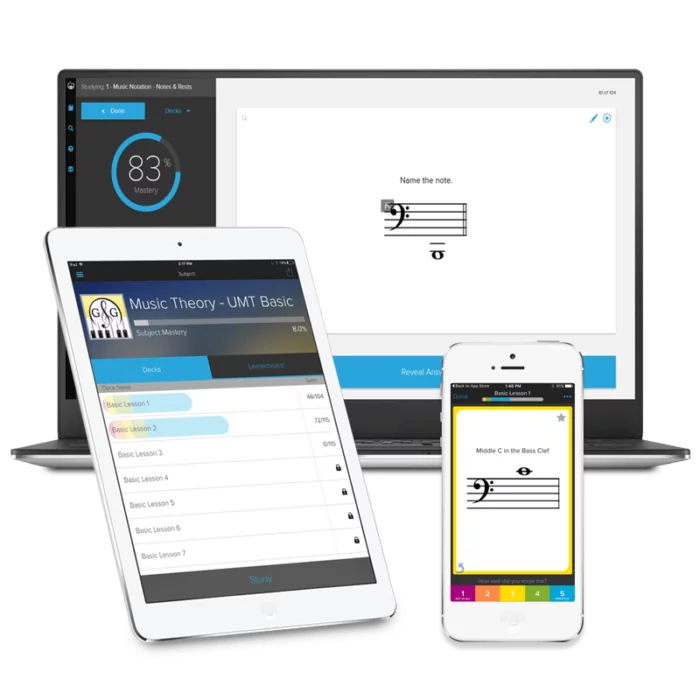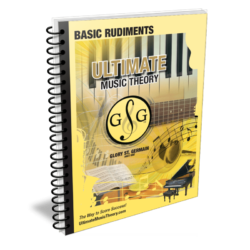
Basic Rudiments may be completed together with the UMT Supplemental Workbook Levels.
LEVEL 4 Supplemental Workbook is designed to be completed with the Basic Rudiments.
LEVEL 5 Supplemental Workbook is designed to be completed after both Basic and LEVEL 4.
Supplemental Books include Melody Writing, History & Much More!
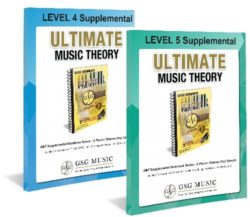
LEVEL 4 Supplemental Workbook
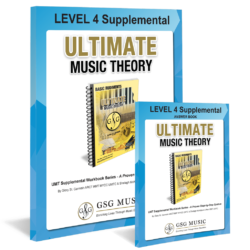
The LEVEL 4 Supplemental Workbook is designed to be completed with the Basic Rudiments Workbook. The Identical Matching Answer Book is a handy resource for quick, easy and accurate marking.
LEVEL 4 Supplemental Workbook Pages 48 - 55 - Music History Videos are provided for you as a Free Resource when completing the LEVEL 4 Workbook pages.
LEVEL 4 Supplemental Workbook Pages 48 - 51 - Orchestra Families & Instruments, Range Chart and Tone Color (Timbre).
LEVEL 4 Supplemental Workbook Pages 52 - 53 - The Young Person’s Guide to the Orchestra by Benjamin Britten.
LEVEL 4 Supplemental Workbook Pages 54 - 55 - The Nutcracker by Pyotr Il’yich Tchaikovsky (Dance of the Sugar Plum Fairy and Waltz of the Flowers).
Young Person’s Guide to the Orchestra by Benjamin Britten
- Illustrated – Presentation narrated by Sir Peter Pears including an index of the sections of the piece and instruments introduced by the variations. Listen as he guides you through each section and shows you the instruments being introduced.
- Performance – The Young Persons Guide to the Orchestra. Watch how each instrument is played.
- Transcript – Orchestral Score of the music for The Young Persons Guide to the Orchestra. Follow along with the written score as you listen to the music. You be the conductor!
Illustrated – The Young Person’s Guide to the Orchestra (See INDEX below the video.)
“The Young Person’s Guide to the Orchestra” was composed by Benjamin Britten in 1945 (completed on New Year’s Eve 1945 in fact) with a subtitle “Variations and Fugue on a Theme of Purcell”. It was originally commissioned for an educational documentary film called Instruments of the Orchestra, directed by Muir Mathieson and featuring the London Symphony Orchestra conducted by Sir Malcolm Sargent. It was first performed in public in late 1946.
Level 4 Supplementary Workbook Pages 52 - 53. Answer the questions as you listen to the Young Person's Guide to the Orchestra.
The sections of the piece and instruments introduced by the variations are as follows. INDEX:
02:40 – Theme: Allegro maestoso e largamente Tutti, Woodwinds, Brass, Strings, then Percussion
03:18 – Variation 1: Presto: Piccolo and Flute
03:49 – Variation 2: Lento: Oboes
05:07 – Variation 3: Moderato: Clarinets
05:50 – Variation 4: Allegro alla marcia: Bassoons
06:46 – Variation 5: Brillante: alla polacca: Violins
07:33 – Variation 6: Meno mosso: Violas
08:43 – Variation 7: Cellos
09:54 – Variation 8: Cominciando lento ma poco a poco accel. al Allegro: Double Basses
10:55 – Variation 9: Maestoso: Harp
11:50 – Variation 10: L’istesso tempo: French Horns
12:53 – Variation 11: Vivace: Trumpets
13:26 – Variation 12: Allegro pomposo: Trombones and Bass-Tuba
14:33 – Variation 13: Moderato: Percussion (Timpani; Bass Drum & Cymbals; Tambourine & Triangle; Snare Drum & Wood Block; Xylophone; Castanets & Gong; Whip; Percussion Tutti)
16:10 – Fugue: Tutti, Allegro molto
Philharmonia Orchestra
Conductor: Igor Markevitch
Narrated by Sir Peter Pears
The Young Person’s Guide to the Orchestra – Performed by Kölner Philharmonie – WDR Sinfonieorchester Köln and Conducted by: Jukka Pekka Saraste (Chefdirigent).
Performance – The Young Person’s Guide to the Orchestra by Benjamin Britten
Transcript – Orchestral Score of The Young Persons Guide to the Orchestra by Benjamin Britten
A Conductor must read quickly! What does the music look like when a conductor has to read the music for all instruments at the same time, while conducting the full orchestra? Below is a transcript of the music so you can see the score for each instrument and how they are presented for the conductor.
Now, you be the conductor and follow the music as you listen to the performance.
Fun Animated Adaptation
2. Dance of the Sugar Plum Fairy from The Nutcracker by Pyotr Ilyich Tchaikovsky
“The Nutcracker” was composed by Pyotr Ilyich Tchaikovsky in 1892. The ballet was based on Hoffmann’s 1816 fairy tale “The Nutcracker and the Mouse King”.
Level 4 Supplementary Workbook Page 54. Answer the questions as you listen to the music. Act 2 of The Nutcracker begins with the Dance of the Sugar Plum Fairy (violins, harp and celesta).
Listen and Learn How the Celesta Creates It’s Magical Sound.
Waltz of the Flowers from The Nutcracker by Pyotr Ilyich Tchaikovsky
Level 4 Supplementary Workbook Page 55. Answer the questions as you listen to the Waltz of the Flowers. The Nutcracker continues with the story as it moves to The Waltz of the Flowers where the spotlight falls on the harp, then on the 4 horns introducing the main theme, then the strings with a beautiful melody.
The Nutcracker – Complete Ballet – Act 1 and Act 2. Enjoy!
The Nutcracker is one of Tchaikovsky’s great masterpieces. Watch the conductor, musicians and dancers as they take us through the magical story of The Nutcracker.
The sections of the ballet are presented as follows.
INDEX:
0:00 Act I
29:39 Act II
52:08 (Prelude to) Act III
Dances in Act III:
55:58 Spanish Dance
1:02:29 Eastern Dance
1:07:12 Chinese Dance
1:08:36 Trepak (Russian Dance)
1:09:59 Pas de trois (Dance of the reed pipes)
1:13:38 Waltz of the Flowers
1:21:05 Pas de deux – Intrada
1:27:57 Pas de deux – Tarantella
1:29:05 Pas de deux – Dance of the sugar plum fairy
1:31:31 Pas de deux – Coda
1:33:32 Final Waltz and Apotheosis
These Resources are organized here for your convenience. If you have any requests, questions or suggestions, please feel free to contact us.
We'd love to hear from you! The GSG MUSIC Team.
Enriching Lives Through Music Education
The LEVEL 4 Supplemental Workbook features these concepts and more!
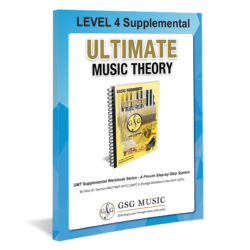
- PITCH - Transposition up or down one octave, including change of clef
- SCALES - Major, minor (natural, harmonic & melodic) up to three sharps or three flats
- CHORDS - Tonic, Subdominant and Dominant of required keys, Functional and root/quality chord symbols
- INTERVALS - Major, minor, Perfect - up to an octave, (Melodic and Harmonic)
- MELODY WRITING - Four-Measure Melody Writing (Major key), Ending Stable Scale Degrees
- ANALYSIS - Identification of sections (A and B), and concepts from previous levels, Musical Terms
- MUSIC HISTORY - Life and Music of Benjamin Britten and Pyotr Tchaikovsky
- THEORY EXAM - Level 4
The Ultimate Music Theory™ Program and Supplemental Workbooks help students prepare for nationally recognized theory examinations including the Royal Conservatory of Music. Note: UMT Answer Books are available for ALL Levels.
- LEARN FASTER – Use on any device, phone, tablet, computer
- EXPLORE – Identify written & audio notation
- PLAY – Sight Reading and Ear Training Games and much More!
Students will LOVE hearing exact pitch and pronunciation of terms.
Students will be INSPIRED to use their imagination while building a foundation in Ear Training and Sight Reading.
The One and ONLY Music Theory App & Matching Workbook!
